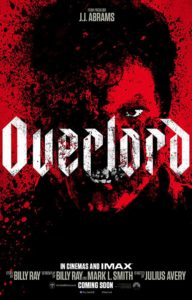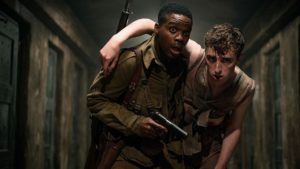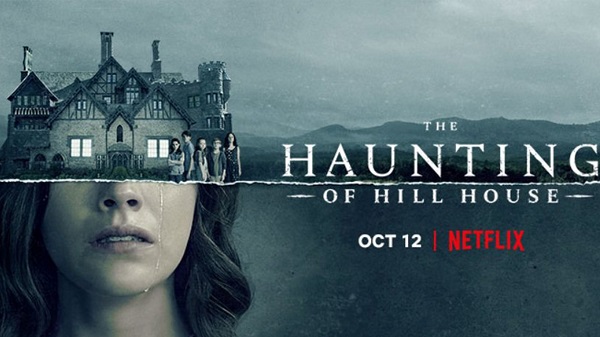 J.J. Abrams’ Bad Robot studios have surprised with genre movie conventions layering callbacks to their B-movie origins and bigger cinematic influences. 2001’s Joy Ride the first feature-length movie ever produced by Abrams’ studio, mixed thriller pulp storytelling about a mysterious killer in a semi-truck with cinematic callbacks to Steven Spielberg’s Duel, a TV movie also featuring an unseen killer in a tractor trailer. Likewise, the Cloverfield movies took genre conventions and couched them in unexpected Sci-Fi twists and turns, both enriching the world it’s characters inhabited as well as heightening the suspense and thrill-factor. Audiences and critics responded well, praising both their take on source material and unblinking commitment to its sensational material.
J.J. Abrams’ Bad Robot studios have surprised with genre movie conventions layering callbacks to their B-movie origins and bigger cinematic influences. 2001’s Joy Ride the first feature-length movie ever produced by Abrams’ studio, mixed thriller pulp storytelling about a mysterious killer in a semi-truck with cinematic callbacks to Steven Spielberg’s Duel, a TV movie also featuring an unseen killer in a tractor trailer. Likewise, the Cloverfield movies took genre conventions and couched them in unexpected Sci-Fi twists and turns, both enriching the world it’s characters inhabited as well as heightening the suspense and thrill-factor. Audiences and critics responded well, praising both their take on source material and unblinking commitment to its sensational material.
Hoping to continue building on previous successes, producer Abrams and Bad Robot bring us the late-to-the-Halloween-party horror war thriller, Overlord. Directed by Australian Julius Avery, directing his sophomore feature-length film after 2008’s Cannes-winning short film Jerrycan, the movie follows Private Boyce (Jovan Adepo) as an anachronistic member–African-Americans were not integrated in the military until 1948–of the 501st Airborne Unit as they parachute into France the night before D-Day to destroy a church bell tower converted into a German communications array. When their unit is killed and scattered by Nazi fire, only their last-minute addition demolitions expert Corporal Ford (Wyatt Russell), sniper Tibbett (John Magaro), and photographer Chase (Iain De Caestecker), survive to complete the mission. Their prospects are buoyed when they meet a French villager, Chloe (Mathilde Ollivier), and she agrees to house them and help them infiltrate the church and take out the tower. Little do they know the church and Chloe’s village hold terrible secrets of Nazi operations far more sinister and deadly than a communications tower scrambling Allied signals.
Their plans are thrown into disarray with Boyce’s shocking discoveries of Nazi experiments to realize Hitler’s vision of his “thousand-year-soldiers”. Allied prisoners and French citizens are being experimented on to resurrect dead flesh and essentially create zombified super soldiers reminiscent of the blood-shot virus-infected zombies of 28 days Later. What starts as a mission to take out a tower mutates into a desperate operation to complete their initial objective but also survive and destroy the undead horrors uncovered in the catacombs of this simple French hamlet.
Borrowing heavily from B-movies like Frozen Dead, Dead Snow, and Blood Creek, Overlord drips and bubbles with dingy intensity. Avery builds a palatable air of suspense, owing both to the mysterious goings-on in Chloe’s home, as well as the unit’s goal to remain stealthy undetected. Eventually, the movie’s simmering suspense is exploded when Wafner, a German commander played with scenery-chewing delight by Pilou Asbæk, who also plays the grinning, scenery-chewing Euron Greyjoy in Game of Thrones, discovers the unit and, despite being captured, manages to take one of them out and then escape.

Asbæk is probably the best thing about the whole movie. He seems to be the one who understands and appreciates the movie’s hammy origins the most. Smugly growling throughout, he also becomes the “big baddie” when a mortal wound forces him to take drastic steps and become one of the oft-teased super soldiers. It’s at this moment the movie fully embraces it’s pulpy roots and goes full gory mayhem. Other experiments get released and the movie becomes a video game, filled with slimy zombies, spraying blood, lots of explosions, and a generous sprinkling of flamethrowers. While the action is far from ground-breaking and its borders on predictable, it makes the last third of the movie pulse with high stakes and gruesome action becoming of its influences. Fans of the genre will love it, reveling in the gloomy aesthetic and high-intensity zombie flick combined with a Call of Duty and Saving Private Ryan milieu.
At the conclusion of the story, much like 2015’s 10 Cloverfield Lane, it ends with an ethical choice by Adepo’s Boyce. Russell’s Ford, who, until experiencing the experimental horrors in the final third, is hyper-focused on the Allied mission. Yet, when the time comes to blow up the communications tower, prioritizes the destruction of the lab. Boyce is then left after the fallout to debrief with his commanding officers. It begs an important question when confronted by something horrific perpetrated by your enemy, which could easily be turned to your side’s advantage. Ford is adamant the lab must be destroyed to not only prevent the Nazi’s from experimenting but also the Allies discovering what the Nazis have been up to. Boyce’s ultimate choice leaves the viewer questioning; are the horrific findings of the enemy something to be discovered and potentially weaponized by the winning side, or are both sides in a war ultimately not to be trusted. Like it’s Sci-Fi B-movie roots, the viewer is left to grapple with the carnage on-screen with a slightly ham-fisted but sincere moral quandary. Overlord, while being a little over-the-top, anachronistic in its casting–it is a Nazi ZOMBIE movie after all–and somewhat predictable earns its stripes in the end and succeeds in being a good homage to previous films of its ilk and contemporary of Bad Robot’s A-movie genre flicks.
Review| Overlord
Previous articleThe Good Place: Season 2 Next article Review| The Haunting of Hill House: A Grief Unobserved
Next article Review| The Haunting of Hill House: A Grief Unobserved
 Next article Review| The Haunting of Hill House: A Grief Unobserved
Next article Review| The Haunting of Hill House: A Grief Unobserved
